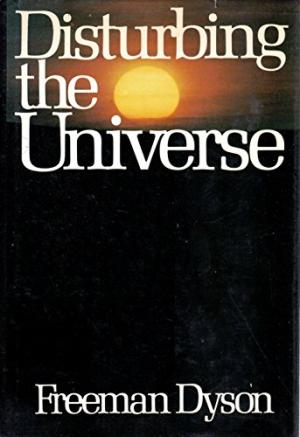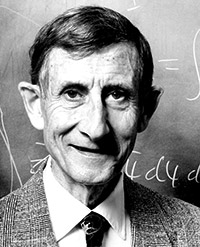Dyson is sometimes said to be the greatest physicist never to win a Nobel Prize, settling instead with having a space craft named for him in ‘Star Trek.’ The book is autobiographical but not an autobiography. Huh?
The essays set forth something of his life and career as a scientist from his first absorption in and simple adsorption of mathematics, to statistical analysis during World War II in Bomber Command, to theoretical work in the Cold War… That is autobiographical part. However it does not offer much of the private man, though we do find out some of his personal life there is no interior, and it is shorn of any reflections on the might-have-beens in his life. The ruminations, and there are a few, are about science and scientists and those they effect or effect them.

He, by the way, was perhaps among the one million Allied soldiers estimated to be killed in the conquest of Japan, who was saved by the atomic bombs. He had been ordered to Okinawa with a contingent of RAF Bomber Command to join the aerial campaign against Japan in anticipation of a sea landing in November 1946. The Allied planners had assumed one million (1,000,000) Allied causalities to subdue the islands of Japan, based largely not the resistance on Iwo Jima and then Okinawa. He read the news of the first atomic bomb en route to the boat train for the Orient. His orders were altered, and he was demobilised. (The planners also assumed ten times that many Japanese deaths in the conflict and untold numbers later in the devastation of the entire country that would be necessary to subdue it.) The planners also assumed nearly all of these Allied casualties would be Americans, since the other Allies were depleted by the war in Europe and that the Soviet Union would play the waiting game, if for no other reason than in retaliation for the tardy opening of the second front in Europe in 1944. Among the many contingency plans for this operation was, after Japan had been bombed flat, to convert air force personnel to infantry and send them into the charnel house. One such flyboy being converted to infantry in 1945 was my father.
‘The Children’s Crusade’ is the chapter about his RAF experiences. It is an absolutely outstanding account of bureaucratic pathology. I used it a number of times in teaching. The more lies told, the more innocents murdered, the more lives thrown away, the greater the prestige of Bomber Command, the more knighthoods distributed, the larger the budget to continue the mayhem, the less rational analysis occurred. Nothing unique about it, but he lays it all out in a way that is all too familiar.
He started a PhD and sent a year at Cornell University with Hans Bethe, who sent him on to the Institute of Advanced Study in Princeton New Jersey to work with J. Robert Oppenheimer. Many of the Los Alamos scientists, apart from Oppenheimer, had been hired by Cornell. (Chicago got the rest.) Entering their company was exhilarating and frightening to the young Dyson. They had won the Pacific War with their brains, it seemed to him, and now he was one of them, well, not really, but he was among them.
He found Cornell and later the Institute very different from Cambridge where he started the PhD research earlier. First, there was plenty of everything from butter to test tubes and clean, crisp white paper. To a theorist like Dyson, who quickly proved himself so inept at experiments as to be a danger to anyone else working nearby, the clean, crisp, empty white paper was a thrill. (Reminded me of paper elsewhere.) Second, he found the informality of first names, all lining up together for lunch, and sitting at one table different from both the RAF Bomber Command, of course, but also from the class, status, and hierarchy consciousness of Cambridge high tables.
There was another distinguishing feature that stayed with him. The anguish of the atomic scientists at having unleashed the atom. Most days at lunch or coffee someone would talk about it as a moral question, as moral guilt, as a genie that would not go back into the lamp, as the last consuming sin of hubris.
It is in this context that Dyson interprets Fredrick Teller’s fatal testimony against Oppenheimer, and it makes sense in this telling. Oppenheimer was so distraught, feeling ashamed and guilty, stunned, confused by the enormity of nuclear weapons that he had become unstable, volatile, sleepless, haunted, and so was not fit for duty. Teller was trying to make a specific and limited criticism of Oppenheimer’s fitness for the job as director of the Atomic Energy Commission, but in the hysteria of the time and place it got blown out of proportion and Teller never lived down this betrayal of his mentor, doing himself as much damage as he did Oppenheimer. Of course, Teller might well have realised that once he took a public side, it would spin out of his control. Too bad the principals of Wikileaks did not learn from such an example. Once it is out, it is out of control. This is one of many examples in the book of the disservice the media does to reason and rationality with its remorseless, cheap sensationalism.
Toward the middle of the book is the story of Matthew Meselson, a biologist, who won a single-handed victory in the Nixon Administration. Armed with reason and evidence he convinced the National Security Council, which in turn convinced President Nixon, to end military research into chemical and biological weapons: One man with an idea, per John Stuart Mill. Moreover, having renounced CBW (chemical and biological warfare) the Nixon administration convinced the Soviet government to do the same, completely in contradiction to the conventional wisdom. This is a marvellous story which was swamped too soon by the tale of Watergate. In order to slip it past domestic opposition, Nixon played it all so low key many involved did not realise it was done, least of all the sensation-seeking media. No great rhetoric but an achievement for the ages. Dyson was one of the scribes doing the technical work on the reports and proposals that went into this effort.
Nixon also deserves credit for listening to the arguments of Daniel P. Moynihan about cities as per Stephen Hess, ‘The President and the Professor’ (2014) but again, to out manoeuvre opponents on the right, Nixon did so with no fanfare to attract the the attention of the jaded hacks.
Dyson like many of his scientific colleagues drew strength from poetry and music. Indeed he often tried to understand what he was doing by finding poems that expressed it. The same with music. He emerges from this book as a modest and direct individual with a great deal of intellect and capacity for meeting challenges, solving problems, indeed, but not only technical ones.
 Freeman Dyson.
Freeman Dyson.
Lee Hansen first enticed me to read this book, and I used the chapter about Dyson’s experiences in bomber Command many times in teaching to demonstrate the pathologies of large organisations. I lent it to a friend and when he returned it, I opened it and started to read it again. I had thought of it last year when we saw ‘Particle Theory’ about the God-particle, and I noticed the enormous spectacles on the nose of an owlish man in the audience; it was Dyson.
While in the States Dyson did what so many exchange students have done there, including Jacques Chirac, and criss-crossed the country by bus. Dyson chose his destinations according to his finances and the physicists he might meet at the destinations, either by attending lectures or knocking on the office door, things he would never have done in England.
Skip to content
